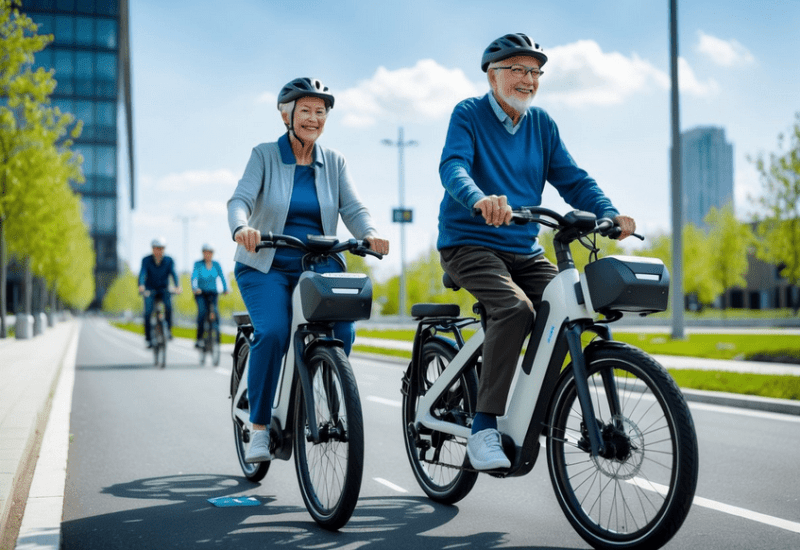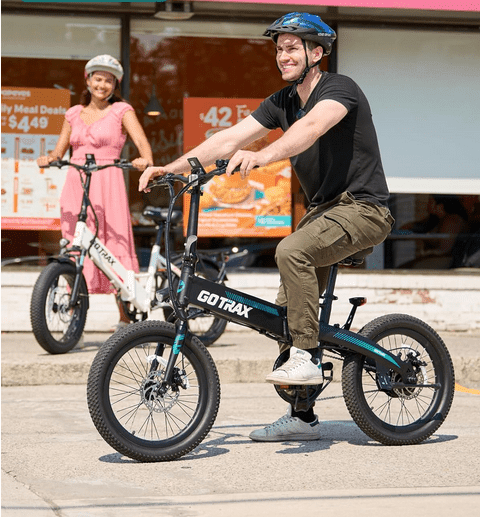Did you know 52% of e-bike owners use their bikes daily or weekly? This shows how electric bicycles are becoming a popular choice for daily travel. We'll look into how e-bikes are changing the way we get around.
E-bikes are becoming a hit among all kinds of cyclists. They make it easier to ride longer distances and tackle tough paths. If you want to try an e-bike without spending a lot, conversion kits are a budget-friendly option.
Turning your bike into an electric one lets you enjoy pedal-assist tech without buying a new e-bike. Luna Cycle's DIY E-Bike kit is around $1100. It makes upgrading your bike to a battery-powered one easier than ever.
When thinking about converting your bike, consider a few things. Look at fork size, rear stay width, wheel sizes, and brake types. Also, think about motor placement, battery specs, and wattage. We'll help you navigate these details for a smooth switch to an electric bike.
Key Takeaways
- E-bikes are becoming a popular alternative to cars for daily commutes and errands
- Conversion kits offer an affordable way to transform regular bikes into electric bicycles
- Factors like motor location, battery type, and bike compatibility are crucial for successful conversions
- E-bike conversions can significantly extend cycling range and tackle challenging terrains
- Understanding your riding needs and bike specifications is essential for choosing the right conversion kit
Understanding E-Bike Conversion Options and Benefits
E-bike conversion is a great way to make your bike more eco-friendly. It turns your traditional bike into a powerful electric bike. We'll look at different electric bike retrofit options to help you choose.
Front Hub Motor Conversions
Front hub motors are easy to install, making them a popular choice. The Swytch Kit, for example, only adds 3.3 lbs to your bike's front wheel. This makes it a light option for turning your bike into an electric one.
https://youtube.com/watch?v=wCZK3oxvSgc
Mid-Drive Motor Systems
Mid-drive motors give better weight distribution and more torque, great for hills. They're a bit harder to install but offer a balanced ride. This makes your commute more sustainable.
Rear Hub Motor Solutions
Rear hub motors are a budget-friendly option. They provide good traction and stability, especially for mountain bikes. They're perfect for those looking for power without spending a lot.
Friction Drive Alternatives
Friction drive systems, like the Rubbee X, are easy to install and work with many bikes. They're ideal for those who want a removable e-bike conversion. This gives you flexibility in your eco-friendly biking journey.
| Conversion Type | Weight Added | Installation Difficulty | Best For |
|---|---|---|---|
| Front Hub | 3.3 lbs (motor) | Easy | Beginners |
| Mid-Drive | 5-7 lbs | Complex | Hill climbing |
| Rear Hub | 4-6 lbs | Moderate | All-round use |
| Friction Drive | 2-4 lbs | Very Easy | Versatility |
Choosing the right e-bike conversion kit depends on your needs and bike type. There are options for every budget and preference. You can find the perfect kit to match your riding style.
Cost Considerations and Budget Planning
Switching to an e-bike means understanding the costs. We'll look at the initial cost, long-term savings, and installation options. This will help you decide on sustainable transportation.
Initial Investment Analysis
The cost of owning an e-bike starts with the conversion kit. Prices vary from $359 to $1,395, based on features and quality. High-end models offer better performance but cost more. Here are the average costs for different e-bike types:
| E-Bike Type | Average Cost | Price Range |
|---|---|---|
| Cruiser | $3,050 | $1,500 - $7,900 |
| Mountain | $4,150 | $1,200 - $9,000 |
| Road | $4,750 | $1,900 - $8,000 |
| City | $2,800 | $1,200 - $8,000 |
| Folding | $1,750 | $700 - $5,000 |
| Cargo | $3,300 | $1,700 - $6,000 |
Long-term Cost Benefits
E-bikes are great for eco-friendly commuting. The initial cost is high, but the long-term benefits are huge. They save money, reduce environmental impact, and improve health. E-bikes are a smart choice for sustainable travel.
DIY vs Professional Installation Costs
DIY installation can save money if you have the skills and tools. Professional installation ensures it's done right but costs more. Think about these when planning your budget:
- Battery replacement: $500 - $800
- Tune-up: $75 - $100+
- Flat tire fix: $10 - $20
- Brake adjustment: $20 - $35
- Drivetrain maintenance: $20 - $60
Don't forget to include ongoing maintenance and upgrades in your budget. With proper care, your e-bike will last for years, saving you money and being eco-friendly.
Essential Components for Electric Conversion
Turning a regular bike into an electric one needs careful picking of key parts. We'll look at the main things needed, like batteries, motors, and control systems.
Battery Types and Specifications
The battery is the heart of an electric bike kit. Most kits use 36V or 48V batteries. This balance gives power without being too heavy. For example, the Swytch eBike Conversion Kit has options for 15km or 30km ranges, meeting different needs.
Motor Power and Torque Requirements
Electric bike motors vary in power, from 300W to 600W. The TongSheng TSDZ2 Mid Drive Motor has 80Nm torque, great for hills. On the other hand, the Voilamart 48V rear wheel kit has 45Nm, better for flat areas.
Controllers and Display Units
Controllers manage power from the battery to the motor. Display units show important ride info. Together, they help control the bike's performance and let riders track their ride.
Wiring and Connection Systems
Good wiring is key for a safe and efficient e-bike. Quality connections between the battery, motor, and control systems are vital. They ensure the bike works well and lasts long.
| Component | Specification | Example |
|---|---|---|
| Battery | 36V or 48V | Swytch eBike Kit (15km/30km range) |
| Motor | 300W-600W | TongSheng TSDZ2 (80Nm torque) |
| Rear Wheel Kit | 48V | Voilamart (45Nm torque) |
| Off-Road Kit | High Torque | Bafang Mid Motor Kit (80Nm torque) |
When picking parts for your electric bike, think about your riding style, the terrain, and how far you want to go. Getting a pro to install it ensures safety and precision. But, doing it yourself can help you understand your e-bike better.
Transitioning from a regular bike to an electric bike
Switching to an e-bike opens up a world of new possibilities. Over 80,000 riders worldwide have made the switch using kits like Swytch. This change brings exciting new ways to ride and maintain your bike.
Electric bicycle assistance comes in various forms. The Swytch Kit, for example, offers a 250W front motor wheel with 40Nm of torque. This power boost can help you tackle hills and extend your riding range significantly.
When it comes to battery range for e-bikes, options vary. The Swytch Kit provides choices from 15-20 miles up to 45-60 miles. The AIR power pack offers 7-10 miles or 15-20 miles range. Your actual range depends on terrain and how you use the power assist.
Riding modes on electric bikes allow you to customize your experience. Some kits offer optional LED or OLED displays for viewing battery levels and adjusting power settings. In the UK and EU, these bikes typically max out at 15mph, while in the USA, the limit is 20mph.
E-bike maintenance tips are crucial for longevity. Regular checks of your motor, battery, and electrical connections are key. Remember, your e-bike may require more frequent tune-ups due to the added components.
Charging electric bikes is straightforward. The Swytch Kit includes a 2A charger that provides about 10 miles of range per hour of charging. This makes it easy to keep your e-bike ready for daily commutes or weekend adventures.
| Kit Type | Motor Power | Torque | Max Range |
|---|---|---|---|
| Swytch Kit | 250W | 40Nm | 60 miles |
| TongSheng TSDZ2 | Varies | 80Nm | Varies |
| Voilamart Rear Wheel | 48V | 45Nm | Varies |
| Bafang Mid Motor | Varies | 80Nm | Varies |
Performance Expectations and Riding Experience
Switching to pedal-assist bikes brings new fun to your daily rides. Let's dive into the exciting features and experiences you'll enjoy with your e-bike.
Range and Speed Capabilities
The range of your e-bike depends on where you ride and how much you pedal. Most e-bikes can go 30 to 50 km on one charge. In the US, they usually top out at 20 mph for safety.
The electric motor's power is key. Many e-bikes have a 250W motor.
Pedal Assist Levels
E-bikes often have different power levels. These levels help you use less battery while still getting a boost. You'll find 3-5 levels, each giving a unique amount of help as you pedal.
Handling Changes and Adjustments
Going electric changes how your bike handles. The extra weight and different balance need new ways to turn and stop. But, you'll get better grip, especially with all-wheel-drive.
| Feature | Typical Range | Impact on Riding |
|---|---|---|
| Battery Range | 30-50 km | Longer rides without fatigue |
| Top Speed | 20 mph (US) | Faster commutes, easier hill climbs |
| Assist Levels | 3-5 settings | Customizable riding experience |
| Weight Increase | 10-15 lbs | Enhanced stability, requires handling adjustment |
Your e-bike becomes a great way to get around, whether for work or fun. It's efficient and fun, making every ride better.
Maintenance and Care for Your Converted E-Bike
Keeping your electric bike in good shape is key for a great ride and saving money. We'll show you how to care for your e-bike to keep it running smoothly.
Cleaning your e-bike regularly is important. Wipe it down after each ride, focusing on the motor and battery. This helps your bike last longer.
Looking after your battery is crucial for its performance. Always charge it after riding and keep it in a cool, dry spot. This helps it last longer and keeps its range strong.
- Check tire pressure before rides
- Inspect brake pads regularly
- Lubricate the chain monthly
- Tighten all bolts and connections
It's a good idea to get a professional tune-up every year or after 1,000 miles if you ride a lot. This keeps everything working right and avoids expensive fixes later.
"Regular maintenance not only improves your riding experience but also contributes to the environmental impact by extending the lifespan of your e-bike components."
| Maintenance Task | Frequency | Impact |
|---|---|---|
| Battery charging | After each ride | Extends battery life |
| Tire pressure check | Weekly | Improves range and handling |
| Chain lubrication | Monthly | Reduces wear and noise |
| Professional tune-up | Annually | Ensures overall performance |
By sticking to these maintenance tips, your e-bike will be reliable and efficient for years. A well-cared-for e-bike not only rides better but also helps the environment.
Conclusion
We've looked into the world of electric bicycle upgrades. We found how they offer sustainable mobility and better urban riding. Our exploration showed many options for those wanting to try battery-powered cycling.
E-bikes can go up to 15.5 mph with motor help. They can travel 40 to 75 miles on one charge. They take 2.5 to 8 hours to recharge. Even though they can weigh up to 25 kg, the benefits are huge.
They don't need a license and cost between $1,100 for DIY kits and $3,000 for ready-made ones. E-bikes make eco-friendly travel easy to start.
Looking ahead, electric bicycle upgrades are more than a trend. They mark a move towards smarter, cleaner, and more efficient travel. Whether you choose DIY or a factory-built e-bike, this change brings new chances for all riders.
By adopting this technology, we're not just improving our bikes. We're changing how we travel personally.
FAQ
Q: What are the main benefits of converting a regular bike to an electric bike?
A: Converting your bike to electric can help you travel farther. It's great for replacing car trips for small tasks. You'll save money and help the environment. Plus, it might make you healthier.
It's also a way to enjoy electric cycling without spending a lot. You can keep your bike but add electric power.
Q: What types of e-bike conversion options are available?
A: You can choose from front hub motors, mid-drive motors, rear hub motors, and friction drives. Each has its own benefits.
Front hub motors are easy to install. Mid-drive motors offer better balance. Rear hub motors are affordable. Friction drives are quick to set up.
Q: How much does it cost to convert a regular bike to an electric bike?
A: Conversion kits cost between $359 and $1,395. This depends on the brand and features. If you don't do it yourself, you might pay more for installation.
But, saving money on transportation can make up for the cost over time.
Q: What are the essential components needed for an e-bike conversion?
A: You'll need batteries, motors, controllers, display units, and wiring. The exact parts depend on the kit and your bike.
Q: How do I choose the right battery for my e-bike conversion?
A: Look at voltage, capacity, mounting options, and compatibility. Balance range needs with weight and cost.
Q: What should I expect in terms of range and speed after converting my bike?
A: Ranges vary from 15km to 100km, based on battery and riding conditions. Speeds usually top out at 15.5mph in the UK or 20mph in the US.
Actual performance depends on terrain, rider weight, and assistance levels.
Q: How do I maintain my converted e-bike?
A: Regularly check electrical connections and battery care. Do standard bike maintenance too. Keep the battery charged and stored right.
Clean and lubricate parts, check motor mounts and wiring, and update firmware. Fix any unusual issues quickly.
Q: Are there any handling changes I should be aware of after converting my bike?
A: Yes, the bike may feel heavier and handle differently. You might need to adjust how you turn and brake. Get used to the new feel in a safe area before riding in traffic.
Q: Can I still use my converted e-bike as a regular bike?
A: Yes, most systems let you ride without electric help when you want. But, the added weight might make pedaling harder without the motor.
Q: What are pedal-assist modes, and how do they work?
A: Pedal-assist modes offer different levels of electric support. You can choose from 3-5 settings to balance power and battery use. Higher levels make pedaling easier but use more battery.



